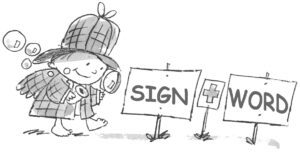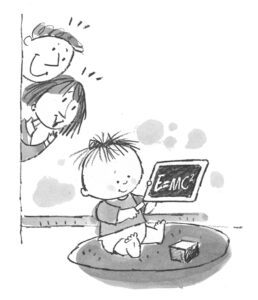Benefits & Research
Benefits
Families who use the Baby Signs® Program know first hand the many benefits of using signs with their babies. Using the Baby Signs® Program:
- Reduces Tears, Tantrums, & Frustration
- Allows Babies to Share Their Worlds
- Increases Respect for Babies
- Strengthens the Parent-Infant Bond
- Boosts Self-Esteem and Self-Confidence
- Makes Learning to Talk Easier
- Stimulates Intellectual Development
More than two decades of Baby Signs® research has shown that these proven benefits affect different areas of a child’s development.
Language Development
Using the Baby Signs® Program Makes Learning to Talk Easier!
Some parents worry that encouraging their children to use signs might slow their learning to talk. The opposite is true! With the help of a large grant from the federal government, Dr. Linda Acredolo and Dr. Susan Goodwyn showed that using the Baby Signs® Program helps babies learn to talk. Just as a child who learns to crawl is more than less motivated to learn to walk, so also a child who learns to sign more, rather than less motivated to learn to talk! The groundbreaking research completed by Baby Signs® authors Dr. Linda Acredolo and Dr. Susan Goodwyn showed extensive benefits for language development, including:By the time they were 2 years old, Baby Signs® babies had significantly larger vocabularies than their non-signing peers. By the time they were three years old, their language skills were more like their four-year-old peers.

Social-Emotional Development
Reduces Tears, Tantrums, and Frustration
By the time babies are 9 to 10 months old, they are quite capable of knowing what they need or want. What they don’t know is how to tell us with words – which leads directly to frustration for baby and parent alike. All this changes when a baby is able to use signs. With signs like “thirsty,” “hungry,” “hot,” and “cold” – and many, many others-at their disposal, babies can make their needs known quickly and quietly without resorting to tantrums and tears. No wonder, “Decreased frustration!” is the answer we frequently get when we ask how using the Baby Signs® Program has changed daily life.
Allows Babies to Share Their Worlds
Just because babies don’t talk doesn’t mean they aren’t paying attention to the world around them. Babies see things, think things, even remember things — and with signs at their command, all this needn’t remain their secret. Parents of Baby Signs® babies quickly learn to see the world through their baby’s eyes and appreciate in a whole new way what an amazing world it is!
Boosts Self-Esteem and Self-Confidence
Good self-esteem boils down to the sense that we are perceived as competent and praiseworthy in both our own eyes and in the eyes of those we love. And that’s just what the ability to use signs yields. Because they can communicate effectively with their caregivers and because their caregivers respond so positively to these communications, Baby Signs® babies develop a sense of pride in their accomplishments that is wonderful to see.

Strengthens the Parent-Child Bond
Communicating means connecting. When you and your baby can communicate, your relationship will grow closer and closer and become more satisfying to both of you.
Cognitive Development
Using the Baby Signs® Program Stimulates Intellectual Development!
Baby Signs® babies are busily using their signs to learn about the world, while their non-signing peers still wait for the words they need to do the same. For example, a Baby Signs® baby may label a piece of broccoli with a sign for “flower” while smiling quizzically, asking, “It looks like a flower, but what is it?” We now know that all this early learning pays off down the road. When Linda and Susan revisited the children from their government-funded study of the Baby Signs® Program after the children had finished second grade, they found that those who had used signs when they were babies had higher IQs than those who had not!

Jumpstarts Intellectual Development
One surprising result of Linda and Susan’s research was the long-term positive effects of signing on children’s intellectual development. Children who used the Baby Signs® Program as infants scored significantly higher on IQ tests when they were 8.
The Science Behind the Signing: Proven Benefits From Two Decades of Scientific Research
Dr. Linda Acredolo and Dr. Susan Goodwyn, the authors of the book Baby Signs: How to Talk with Your Baby Before Your Baby Can Talk, have conducted over two decades of academic research on the use of signs with hearing babies, including a long-term study funded by the National Institutes of Health. Their groundbreaking research describes the proven benefits of the Baby Signs® Program.
Research Highlights
Linda Acredolo, Ph.D., is a Professor Emeritus of Psychology at the University of California, Davis.
Susan Goodwyn, Ph.D., is a Professor of Psychology at California State University, Stanislaus.
Participants
More than 140 families joined our study when their babies were 11 months old. Each family was randomly assigned to a Baby Signs® group or a non-Baby Signs® group. The groups were equivalent at the beginning of the study in terms of the following characteristics: sex and birth order of the children, their tendency to vocalize or verbalize words, and the parent’s education and income levels.
Assessments
The children were assessed using standardized language measures at 11, 15, 19, 24, 30, and 36 months. In addition, as many children as could be reached at age 8 were assessed using the WISC-III IQ test, the most commonly used measure of children’s intelligence.
Results
At 24 months, the Baby Signs® babies were, on average, talking more like 27 or 28-month-olds. This represents more than a three-month advantage over the non-Baby Signs® babies. In addition, the 24-month-old Baby Signs® babies were putting together significantly longer sentences.
At 36 months, Baby Signs® babies were talking like 47-month-olds, putting them almost a year ahead of their average age-mates.
Eight-year-olds who had been Baby Signs® babies scored an average of 12 points higher in IQ than their non-signing peers.
Conclusion
Using Baby Signs® helps children develop both language and cognitive skills.
Academic Research
One reason that the Baby Signs® Program has been so well-received is because it is so firmly grounded in research. Below is a summary of the major research findings from our UC Davis research, as well as from research conducted by Dr. Claire Vallotton, a former UCD graduate student, now a Post Doctoral student at Harvard University and winner of a young investigator award from the World Association for Infant Mental Health (WAIMH).
Results from our NIH-funded study (1989-1998)
- Faster Verbal Development. Babies who had been in the Baby Signs® Program developed both receptive and productive verbal skills faster than those who had not. (Journal of Nonverbal Behavior, 2000)
- Higher IQs: Retested at age 8, the children in our NIH-funded study who been in the Baby Signs® Program as babies scored significantly higher (by 12 points) on IQ tests than children who had not. (International Conference on Infant Studies, Paris, 2000)
- Emotional Benefits. A content analysis of parent interviews indicated that signing was associated with lower frustration, greater respect for babies’ abilities, enriched parent-child relationships, increased interest in books, and enhanced infant self-esteem (Acredolo & Goodwyn, 1996).
Results from Early Head Start (EHS) Intervention Study
EHS families who were encouraged to sign with their children were compared to EHS families who were not in an intervention study in the Yolo County (California) Early Head Start Program conducted by Dr. Vallotton. Results indicated that mothers in the signing families perceived their children as more “reinforcing” and “acceptable,” two important components of a Parenting Stress Index. Why these changes in attitude toward their children? Other results provide clues: Using signs changed the mother child interactions specifically by (a) helping mothers become more “tuned in” to their children’s emotions, (b) increasing the children’s attempts to communicate with their mothers, and (c) decreasing the number of expressions of distress from the children. These results suggest that the addition of signing to EHS curricula for parents is an easy and effective way to improve family interactions in “at-risk” families. (Paper presented at WAIMH Congress, 2006)
Results from UC Davis Child Care Studies
The Baby Signs® Program has been an integral part of the curriculum at the UCD Center for Child & Family Studies since 1990. Using this setting, Dr. Claire Vallotton conducted a study of 10 infants videotaped in interactions with teachers over an 8-month period and a study of 12 toddlers videotaped in interactions with teachers over a 3-month period. The videotapes were coded to provide data relevant to a variety of specific questions. The following were among the results:
- Generally Observed Benefits: Signing in the classroom reduces aggression, builds trust between babies and teachers, provides a “universal language” that facilitates interactions in multi-lingual classrooms, makes teachers more observant and responsive, increases “active” learning, helps daily routines proceed more smoothly. (Paper presented at the Zero to Three 18th National Training Institute, 2003)
- Teacher Responsiveness: Using multiple-regression analyses to account for teachers’ experience, children’s age, individual child effects, and frequency of children’s gestures, the data revealed that the children’s use of signs in response to teachers’ signs predicted more responsiveness from caregivers. (Paper presented at WAIMH Congress, 2006)
- Internal States: Infants and toddlers used signs to express both emotions (e.g., happy, sad, afraid, mad) and feelings (e.g., sleepy, cold, hurt)-both to label their own states and to comment on the states of other children. Such early evidence of empathy is exciting. (In press, Infant Mental Health Journal).
- Conversations: Two-sign combinations were observed as early as 9 months, 3-sign combinations at 12 months. Also, the children routinely used signs to engage in multi- utterance conversations with teachers, with the longest exchange including 16 turns (back and forth) in a conversation about a mom’s departure and eventual return. Paper presented at the International Society for Gesture Studies, June 2007.)
Conclusion
Because the Baby Signs® Program is grounded in research, is so easy to implement, and has so many proven advantages for babies, families, and child care providers, we are confident that the current movement is going to keep on growing until it becomes as accepted and common place for future generations as teaching babies to wave “bye-bye” is today.
For those interested in reading more about the background research concerning the Baby Signs® Program (known in scholarly journals as “symbolic gesturing”), the following articles are recommended. Research
